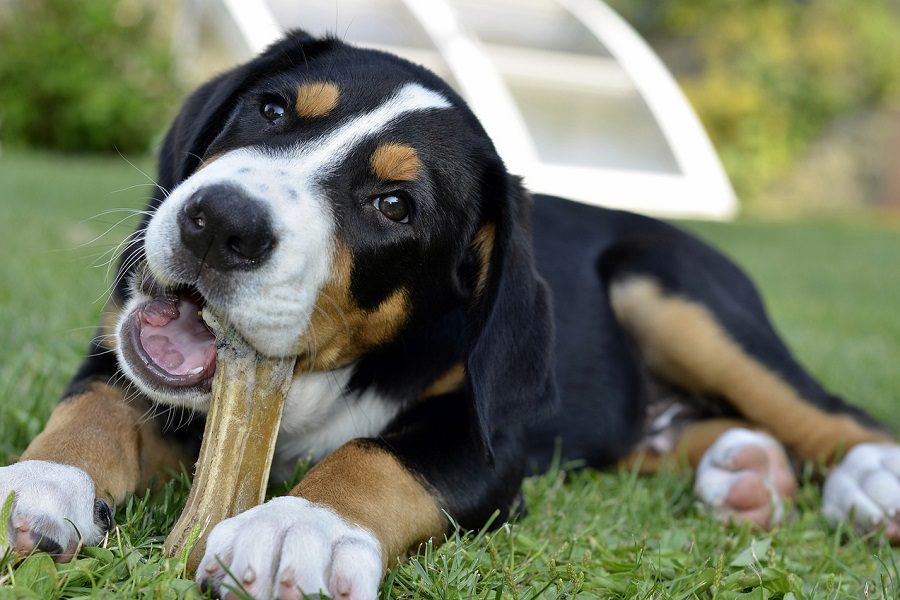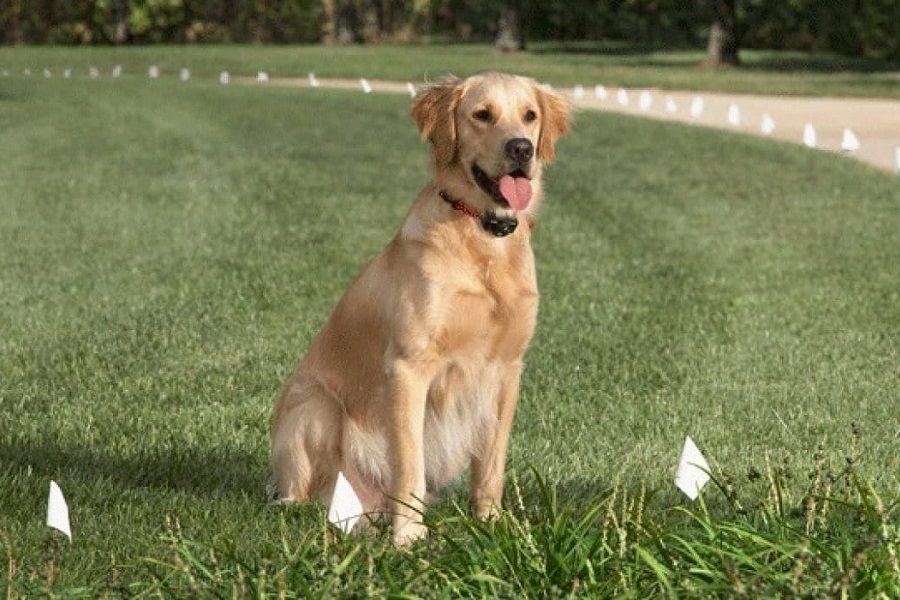Last Updated: 1 year ago
Although many dogs can curl up and seem reasonably comfortable sleeping almost anywhere – in a corner, on the furniture, or sprawled on the lap, your furry pet should not be sleeping on your floor.
Also, you would not want your pooch to climb up on the couch or bed.
To be honest, like us, dogs need beds to sleep comfortably.
Why Your Dog Needs A Bed?
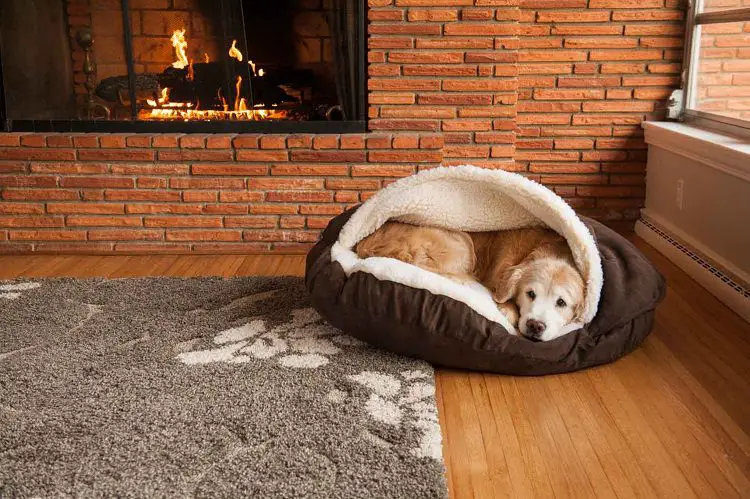
Moreover, dog beds are beneficial for many different reasons. Here are some of the benefits of having a dog bed for your furry friend.
A Personal Place
Just as puppies feel at home and safe in their crates, dog beds are places where dogs can be masters of their domain. Dogs may feel like second-class citizens in a house that belongs to the individuals living in it.
If they have a bed, however, it provides them a place they could retreat to if they need some personal time. Besides, providing your dog a separate sleeping place would prevent him from sleeping in dangerous or uncomfortable positions.
Dogs often try their best to find comfortable sleeping places, and may usually end up cozying up in your bed, tracking dirt on your lovely carpet or scratching up the expensive furniture.
A comfy dog bed that can accommodate the sleeping needs of your beloved pet would keep your dog from nagging you or damaging value items in your home while he tries to nap.
Warmth
Adequate bedding helps insulate the dog from cold floors, in particular tile and wooden floors.
Moreover, the bedding will trap your dog’s body heat and create a cozy and comfortable space for your dog to snuggle.
Health
Regularly sleeping on a hard surface or floor could damage your dog’s health. You can use an orthopedic dog bed to help relieve the discomfort and pain caused by arthritis, hip dysplasia or similar structural ailments.
Moreover, older dogs should be provided orthopedic beds, because they are more vulnerable to these health conditions. Many latest models of dog beds come with other health-promoting features, like cedar chips to help keep out the odor.
Comfort
A padded or cushioned surface is more comfortable and softer to sleep on than a hard floor.
It is particularly true in case of older dogs with arthritis, or dogs that have hip trouble, joint stiffness or similar health problems.
Cleanliness
Let’s be honest: no matter how much you vacuum or sweep your floor, it is not the cleanest or most clean place to sleep.
If you give your canine friend a nice dog bed, it can help him stay clean. In case your dog tracks dirt and mud from outside on his sleeping place, you do not need to worry.
It is because a majority of dog beds have features such as removable liners, making them very easy to clean. A dog bed can hold dander and shed hair in a single, easy-to-clean location.
Injury Prevention
A dog bed can also help avoid serious injuries by preventing your pet from jumping up and down, especially from high furniture. It can primarily benefit older dogs and smaller breeds.
Security
Providing your dog a bed not only gives him his private space, but it is also an excellent way to offer him a sense of security. It is essential to teach the dogs to go to their bed, and it must be a vital part of their training.
Many dogs prefer having their beds in quiet and comfortable places away from the crowd.
What Are The Risks Of Letting Your Dog Sleep With You?
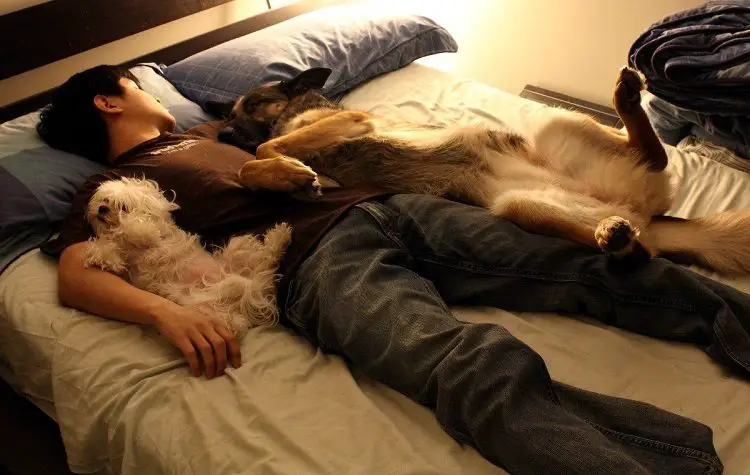
It often catches most individuals off guard when they hear sleeping with their dog is not the best idea.
Companionship, after all, is the main reason they got their furry companion in the first place. However, concerning your health and hygiene, you need to think twice before letting your dog snuggle up with you beneath the sheets.
It can bring along a lot more than just love and warmth. It is because your cuddly and cute dog can probably harbor some bacteria, germs, and bugs among other things. In case you let your dog sleep with you, you are inviting the following risks.
Parasites
Parasites, in most cases, hookworms and roundworms are prevalent in dogs as per the CDC. However, there are many other equally nasty and yucky offenders lurking out there, as well.
These parasites can lay eggs in the dog’s hair and can be quickly shed on your clean sheets. Do you want to sleep near these eggs, especially when they are ready to hatch just next to you?
No Sweet Dreams
Dogs tend to toss and turn in their sleep or even “talk,” and you can expect a kick or two from their hind leg.
These habits are likely to interrupt or disrupt your sleep cycle, which can result in crankiness and lower the immune system response, reducing your alertness during the day.
Staph Infections
You may be aware of this if you are a pet owner. These infections are triggered by bacteria called staphylococcus and include the famous antibiotic-resistant MRSA. The virus could easily affect your dog.
Aggressive Behavior
Your dog may growl or snarl at your spouse or partner when she or he joins you in bed. It is because he might think that he is protecting you because you are in a vulnerable position.
Therefore, your mattress may become your dog’s territory, and anybody who is not wanted, in his eyes, would not feel welcome in this domain.
Ticks
You may know that you could get a nasty tick from a routine stroll into the woods. However, do you know you may also get it from your pet? If your dog has a tick lodged in its fur and joins you in bed, the parasite or flea may latch on you.
Keep in mind that ticks often carry a lot of diseases that are contagious to humans. Some of these illnesses are anaplasmosis and Lyme disease. Ticks are especially prevalent in the Great Lakes Regions.
Mites
These are tiny bugs that are not fun for humans or dogs. And you may end up sharing them in case you sleep with your dog.
A common type of mite is the mange mite, which can cause human scabies, and as the name suggests, the disease is very contagious.
Lifetime Commitment
Your dog may find it difficult to go back to napping or sleeping on the floor or in the crate once he has developed a liking for your cozy bed. And you cannot blame him—he had a cushy pillow and comfy mattress and his best human friend by his side.
So, in case you revert to crate training, always be prepared for restless or sleepless nights, because your pet is likely to keep you awake with constant crying and whining.
Fecal Matter
Let’s face it. If your pooch is just like other dogs, he will either step in or play with poop.
When he comes inside the house and jumps onto your bed, he tracks that poop along with it. It is not just gross; it is also a simple way to transmit bacteria and parasites such as salmonella and E. coli.
Amount Of Sleep For Dogs
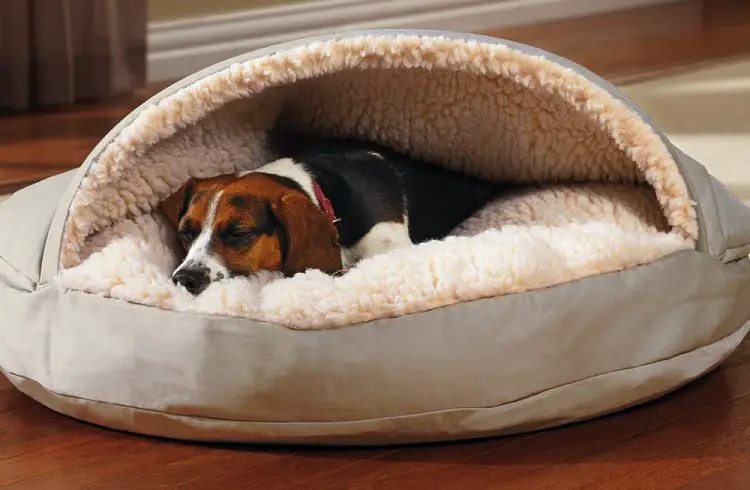
In case you are a dog owner, take a guess: What is your furry animal doing right now?
It is likely that he is sleeping! Isn’t he?
Pet experts and scientists are not entirely sure why dogs tend to doze so much; however, that is usually how they often spend nearly half of their day.
According to a theory, unlike most humans who often stay up during the entire day and sleep for a long stretch during the night, spending up to 25% of the sleep in REM, dogs have much shorter sleep stints.
They spend only 10% of their time in REM sleep. As a result, they require more sleep to make up for the restorative rest that they need.
An average dog may sleep for twelve to fourteen hours a day. However, that is only the beginning.
A majority of puppies, who often expend plenty of energy learning and exploring, may require up to 20 hours of sleep. Similarly, many older dogs also need more rest than young ones, as do specific breeds.
Moreover, both large and small breeds could be long sleepers; however, it is usually the big ones, such as mastiffs, Newfoundlands and St. Bernards, which take seemingly endless naps. The amount of sleeping time for a dog depends on the following factors.
Dog’s Size And Age
Most dogs, on average, spend nearly 15 hours in a day sleeping.
Keep in mind that older dogs require more sleeping time just because life gets more difficult as they age. These dogs tire out or get exhausted more quickly and need full rest to function properly.
Like babies, puppies, spend plenty of time expending energy while exploring and playing in new surroundings. For this reason, they may need up to 20 hours of sleep per day to recoup energy!
Although all dogs require rest, usually the bigger breeds are famous for constant dozing, which is not surprising.
Activity Level
The exact amount of sleep a dog needs may also depend on what it is bred to do. It is necessary, for example, for many working dogs to stay vigilant and aware of their surroundings due to the mental and physical demands they face every day.
Therefore, a dog that has specific tasks that capture his attention would spend a significant part of his day active, committed to completing the tasks. On the other hand, a dog not bred for a specific purpose is likely to lead a more sedentary lifestyle.
Life Changes
Just like humans, if a dog experiences any sudden or unforeseen life changes, it is likely to react. As a majority of dogs adapt quite well to their original environment, any change in their everyday activity may affect them significantly.
The problem can manifest, for example, if their companion dies or if you take them to a new location with a different climate. It is why a dog might require additional sleep to return to its original mood or energy level.
Health
As sleeping is a vital part of a dog’s daily routine, you do not need to worry if your pet enjoys snoozing.
But, in case you notice a dramatic or significant change in your pet’s sleeping routine, or you think something is amiss, it is better to consult your veterinarian promptly. Excessive sleep may give rise to conditions like diabetes, canine depression, and hypothyroidism.
Dog Sleeping Habits
People, who share their homes with a couch potato pooch, are often surprised to see how much their pet happily sleeps away. Your dog’s ancestors may have spent a lot of their time hunting, waking and scavenging for food; but times have changed.
Modern house dogs have an updated to-do list, which usually includes lazily spending about 50% of their day in a tranquil and peaceful dreamland. A majority of adult dogs indulge in an average of twelve to fourteen hours of sleep.
However, this is not a hard and fast rule. For example, hard-working and active police dogs often take fewer naps compared to a lap dog cuddled on a couch at home.
As your cuddly dog matures, it is likely he would sleep a little less; however, once he reaches his golden years, he will sleep often and early. As their bodies slow down and various conditions such as hip dysplasia and arthritis set occur.
Although oversleeping in puppies may not be a real concern for many dog owners, in case you observe your adult dog sleeping more than usual, it might be indicative of a medical condition.
Adulthood is often when a majority of canine diseases start to develop, like hypothyroidism, a widespread disease in middle-aged and adult dogs.
As thyroid hormone can help maintain proper metabolism, a dog with relatively low levels of the hormone usually sleeps more.
It is also more prone to obesity. Although it can seem counterintuitive, many inactive dogs also have insomnia. Insomnia due to inactivity is prevalent, especially in smaller breeds or among dogs that have an urban lifestyle.
Dog Sleeping Positions
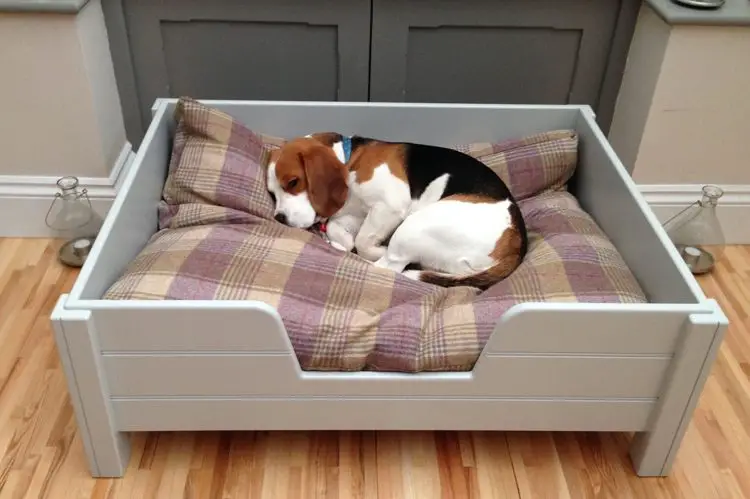
A dog’s favorite or preferred sleeping position may change depending on where he is sleeping, who he is sleeping with or near, or how he is feeling.
Soreness or injury may also cause your dog to change his sleeping position. These are some standard sleeping positions.
Curled Up
A dog often curls up in a ball. Many other animals assume this position while sleeping because it can conserve warmth, protect their vital organs, helps, and make it easier to get up swiftly.
This sleeping angle can limit movement, so you might notice less twitching from your dog if he snoozes in a ball.
On The Side
Dogs that sleep on their side usually feel very comfortable and safe, as this position leaves their vital organs exposed. Your dog may favor this sleeping angle if he is relaxed and easygoing.
However, he might switch to another corner if he is sleeping in a new location or around somebody he has not seen before.
Sprawled Out
This position is also known as the “Superman” position. It lets your dog pop up and quickly get on his feet. It is a standard sleeping position for puppies that tend to nap often, but wish to be ready to play or jump up at just a moment’s notice.
A dog that sleeps in this position does not want to lose any opportunity for action.
On The Back
Sleeping on the back with the belly exposed can help dogs cool off. As the fur is thinnest near the stomach and paws, have plenty of sweat glands.
They sleep on the back to beat the heat and relax. But what happens is they leave their bellies exposed.
Types Of Dog Beds
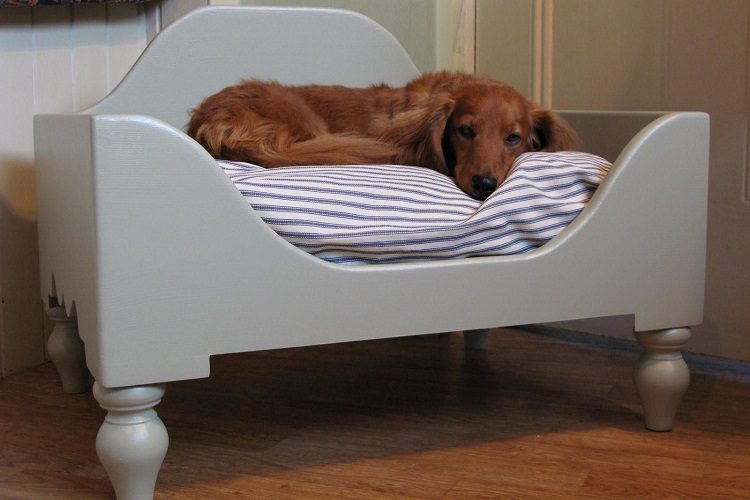
You will find various dog beds on the market. Here are some common types.
Elevated Dog Beds
Many companies produce elevated dog beds. These come in standard or nest designs. The frames are manufactured using wicker, wood, plastic or metal.
Some elevated beds are carefully designed to look just like dog-sized couches. A significant benefit of an elevated bed is that it helps keep plenty of distance between the cold, hard and dirty floor and the dog.
Orthopedic Dog Beds
An orthopedic dog bed is for dogs that have arthritis or an orthopedic problem.
These beds are made of top-quality and thick foam and lend more support for the dog’s body, putting less stress on their joints. Similar to standard beds, orthopedic beds come in a variety of sizes, colors, and shapes.
Chew-Resistant Dog Beds
Chew-proof dog beds are available in various styles.
These beds are not just chew-resistant; they are also water-resistant and can repel germs, stains, and odors with their unique fabric treatment. These beds are ideal if you have a destructive dog.
How To Teach Your Dog To Sleep In His Bed?
Most dogs tend to sleep wherever they like, whether it is on the furniture, or in the middle of a walkway.
If you would want your pooch to rest comfortably on the dog bed, you will need to make that bed more comfy and attractive compared to your bed. Here are some steps that will help:
- Choose a place for your dog’s bed that is not disturbed by regular foot traffic. Your dog will not sleep in his bed if he feels he will have to move often to make way for someone. Try setting up the dog bed under a table or in the corner of a room.
- Place your dog’s favorite toy in his bed so he will begin to understand that the place is safe for him. Also, give your pet some time to play with and chew the toy in the bed.
- Carry or lead your dog to his bed. Repeat the phrase “your bed” a couple of times while pointing in the direction of his bed. Tell him to stay there and then slowly walk away.
Maintenance And Cleaning
Even the cleanest dogs can leave a furry mess and particular odor in their resting spots. Follow these steps to maintain your dog’s bed:
- Vacuum your dog’s bed on a frequent basis. Dander, fur, and dirt your dog drags indoor from laying outside in the grass could be easily kept at bay if you vacuum regularly. Use a vacuum that has hypoallergenic filters to get the best results. It is because these special filters help prevent molecules from getting airborne and minimize their distribution throughout the rooms.
- Choose a natural cleaner to remove stains on your dog’s bed. It will keep your pooch’s sensitive paws and fur from making contact with a harsh detergent.
- Wash the bed frequently. For a quick wash, just remove and thoroughly wash the covers. For a deep clean, wash the whole bed.
- If your dog is outdoorsy and adventurous, frequently treat his bed for ticks by putting the whole bed in your dryer for about ten minutes with high heat to eliminate anything that has latched on.
Conclusion
We have discussed why your dog needs a bed and what are the risks of letting your dog sleep with you.
We have addressed the sleeping habits and rest timings of dogs and the various factors that sleeping times depend on such as age, health, and breed. We have also discussed different sleeping positions such as curled up or on the back.
Moreover, we also talked about different types of dog beds you can opt to buy. These include elevated beds and orthopedic dog beds.
We have provided step-by-step instructions on how you can clean and maintain the dog bed and how to teach your dog to sleep more comfortably.
Resources:


